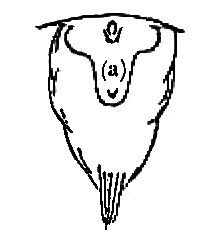To C. S. Bate 18 August [1851]
Down, Farnborough. Kent.
Aug 18th.
My dear Sir.
On my return home after 10 days absence I found your last obliging present of the larvæ,1 & your note had been lying here, & I have since been unwell & much engaged, which must plead my excuse for not having sooner answered your note. I have this morning carefully looked with my 18 glass at the larvæ (& beautiful specimens they are) but I cannot see the transverse articulation referred to.2 I observe that the carapace is often ruptured at the two corners in the line in question, & hence there would probably be a tendency for a fold to be then formed— I certainly do not believe in an articulation3 I send the more important synonyms as far as I have made them out, but I am not a good person to apply to, for I think the number of synonyms often given in works of Nat. History a downright evil & to be avoided— In cirripedia it is impossible in most cases to know what species are referred to in the short published descriptions— I feel pretty certain of the few given. With respect to Chthamalus, I cannot help you for I have not yet worked out the genus—4 I believe the British Species has been named by Italian Naturalists— If you call it the B. punctatus of Montagu5 & not the B. balanoides—I should think would suffice.
Smith & Beck of 6 Colman St City, assure me that the Asphalte which they sell in 1s bottles is better than Gold size for the purpose, I mentioned to you,6 I have got a bottle but have not yet tried it.

I see in the probosciformed mouth of the larva, apparently within it small tubular (a) organ; this would be worth your looking after, if you can get a laterally crushed specimen so that the proboscis projects.
With respect to Ellis’ Paper as it is before Binomial system—I have not troubled myself about it, as I follow Rules of Brit Assoc:7
Pray believe me | My dear Sir. | Yours sincerely. | C. Darwin.
Footnotes
Bibliography
Bate, Charles Spence. 1851. On the development of the Cirripedia. Annals and Magazine of Natural History 2d ser. 8: 324–32.
Correspondence: The correspondence of Charles Darwin. Edited by Frederick Burkhardt et al. 29 vols to date. Cambridge: Cambridge University Press. 1985–.
Ellis, John. 1758. An account of several rare species of barnacles. In a letter to Mr Isaac Romilly, F.R.S. Philosophical Transactions of the Royal Society of London 50: 845–55.
Goodsir, Henry D. S. 1843. On the sexes, organs of reproduction, and mode of development, of the cirripeds. Account of the Maidre of the fishermen, and descriptions of some new species of crustaceans. Edinburgh New Philosophical Journal 35: 88–104.
Linnaeus, Carolus (Carl von Linné). 1758–9. Systema naturæ per regna tria naturæ, secundum classes, ordines, genera, species, cum characteribus, differentiis, synonymis, locis. 10th edition. 2 vols. Stockholm: Laurentius Salvius.
Living Cirripedia (1851): A monograph of the sub-class Cirripedia, with figures of all the species. The Lepadidæ; or, pedunculated cirripedes. By Charles Darwin. London: Ray Society. 1851.
Living Cirripedia (1854): A monograph of the sub-class Cirripedia, with figures of all the species. The Balanidæ (or sessile cirripedes); the Verrucidæ, etc. By Charles Darwin. London: Ray Society. 1854.
Strickland, Hugh Edwin, et al. 1863. Rules for zoological nomenclature . . . authorised by section D of British Association at Manchester, 1842. Edinburgh: British Association for the Advancement of Science.
Summary
Thanks CSB for cirripede larvae.
Has been unwell.
Cannot see transverse articulation referred to and does not believe in it.
Sends species synonyms.
Discussion of Chthamalinae.
Suggests using asphalt to seal specimen containers.
Comments on mouth of larva.
Letter details
- Letter no.
- DCP-LETT-1345
- From
- Charles Robert Darwin
- To
- Charles Spence Bate
- Sent from
- Down
- Source of text
- DAR 143: 45
- Physical description
- C 2pp
Please cite as
Darwin Correspondence Project, “Letter no. 1345,” accessed on 23 April 2024, https://www.darwinproject.ac.uk/letter/?docId=letters/DCP-LETT-1345.xml
Also published in The Correspondence of Charles Darwin, vol. 5


